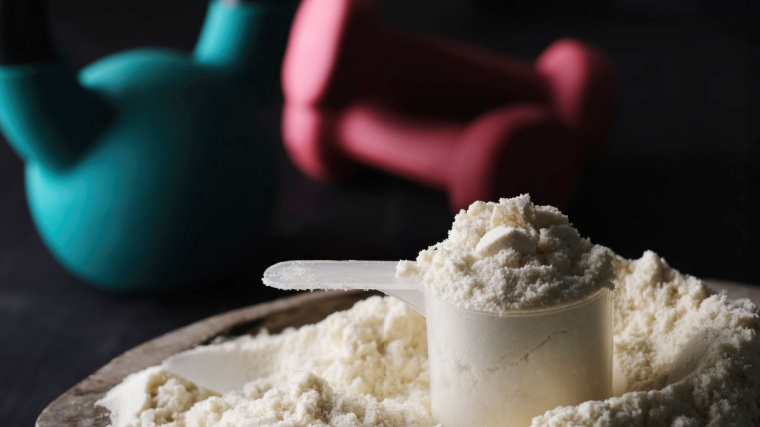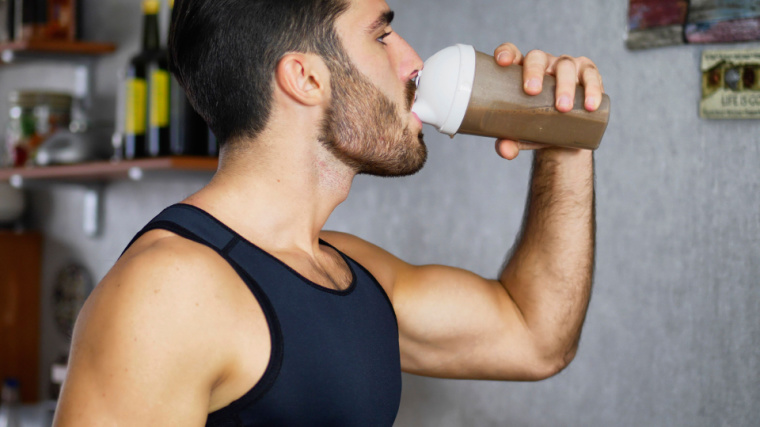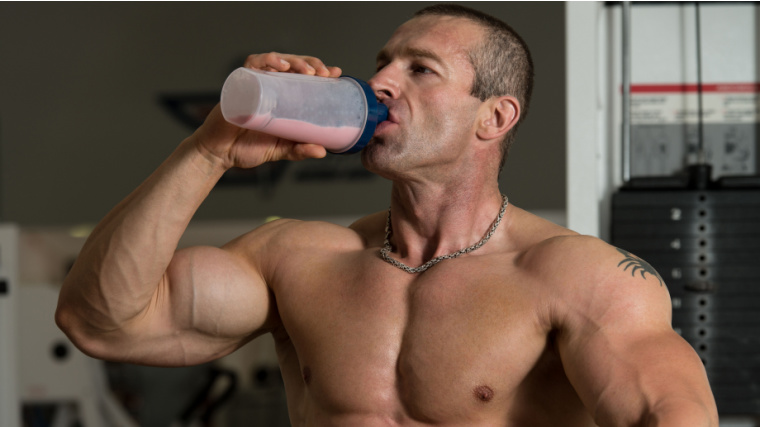Getting to the gym and consistently crushing your workouts makes you feel good and strong; that’s why you love it. In addition to training, keeping your protein intake high can help you build muscle, lose fat, and recover better.
A protein shake is a convenient way to get what you need to fuel those gains, and whey protein powder is one of the best-quality animal-based protein supplements available. You might have a scoop of the stuff in your shaker bottle right now. But whey protein is also a commonly cited acne-producing culprit.

If you’ve noticed increased breakouts while taking it, you may have wondered: does protein powder cause acne? The answer is a solid maybe. Whey protein contains lactose, which could trigger acne in some individuals. Everything you need to know about your gains and your skin is right down below.
- What Is Whey Protein?
- Does Whey Protein Cause Acne?
- The Benefits of Whey Protein
- Whey Protein Alternatives
- Frequently Asked Questions
What Is Whey Protein?
Whey comes from cow’s milk. When milk protein gets broken down, 20 percent is whey, and the remainder is casein protein. Whey is the liquid substance that remains from cow’s milk after cheese is processed and manufactured. Then, the liquid gets removed, and whey gets processed into powder to become whey protein powder. (1)
Whey is a complete, high-quality protein source. A complete protein contains all the essential amino acids your body requires to build muscle. It’s high in leucine, the branched-chain amino acid (BCAA) that is a precursor to muscle protein synthesis. High-quality in this context means that the amino acids can readily be rapidly absorbed. (1)
Whey protein powder is popular with bodybuilders and strength athletes because it can help with muscle growth when combined with resistance training.

[Read More: Whey Protein vs. Casein Protein — What’s the Difference and Which is Better]
The amino acids in whey protein can boost muscle growth and provide other health benefits — it’s not all good news. This milk protein may also be related to your breakouts.
Milk protein contains several growth factors that can trigger acne, including insulin-like growth factor-1 (IGF-1). IGF-1 is a hormone in your blood that may aid tissue and muscle growth. (2)
Does Whey Protein Cause Acne?
There are multiple potential causes of acne. Some observational studies suggest whey protein causes acne. However, there may be other factors at play. It is more well-known that dairy products may trigger acne. Since whey contains lactose, it could have a similar effect.
What Is Acne?
Acne vulgaris is a skin condition involving inflammation of the pilosebaceous unit. The pilosebaceous unit includes hair follicles, hair shafts, and sebaceous glands. When the sebaceous glands excrete sebum, pimples, papules, pustules, and acne breakouts may appear on the skin. They can damage your skin tissue and lead to scarring. (2)(3)(4)
Below are some potential triggers of acne flares. (5)
- Genetics
- Hormone levels
- Increased sebum production
- Abnormal keratinization (cell buildup)
- Inflammation
- Bacteria
Do Dairy Products Cause Acne?
High sebum production is one of the primary acne triggers. Milk contains IGF-1 and androgens (hormones), both of which can increase sebum production. High levels of IGF-1, androgens, and sebum production are expected during puberty, which is why acne often affects adolescents. (4)
For adults, IGF-1 may be a stronger acne trigger for cis women, while androgens may be a stronger trigger for acne in cis men and trans people taking testosterone. (6)
[Read More: 6 Benefits of Whey Protein for Strength Athletes]
A 2018 meta-analysis found a link between people consuming milk, whole milk, low-fat milk, and skim milk with increased acne breakouts. There was no link between yogurt and cheese consumption, highlighting that it may be mainly milk — but not all dairy products — that can trigger acne. Later in 2018, another meta-analysis stated the previous one was flawed because it consisted of observational studies. (7)(4)
Studies on Whey Protein and Acne
Whey protein may most likely trigger acne in acne-prone people. The following studies are small and observational.
In one study, dermatologists and medical students visited gyms where people took whey protein supplements. The study included 30 cis men and women aged 18 to 30. Researchers examined them before taking whey protein, after 30 days, and after 60 days. After 30 days, 56 percent of the participants had acne breakouts. After 60 days, all participants had acne breakouts. (2)

[Read More: What’s the Best Whey: Concentrate, Isolate, Hydrolysate?]
Another study was done on six cis male bodybuilders aged 16 to 18. The participants had acne breakouts on their torsos only. The participants reported that the acne flares began after they started taking whey protein supplements. The researchers hypothesize that increased sweating and friction with clothing may have caused acne on their trunks, not their faces. (5)
The next study was done on five cis male athletes aged 14 to 18. They all experienced acne breakouts after taking whey protein powder to help build muscle or gain weight for playing football. They did not respond to any acne treatments. After they stopped taking whey protein, four participants stopped having acne. (8)
[Read More: Whey Protein vs. Plant Protein — Similarities, Differences, and Benefits]
Lastly, a 2013 study published in the Dermatology Journal notes that five adult cis male bodybuilders began having acne after taking whey protein powder. The writer, a dermatologist, suggested that the milk in whey protein increased IGF-1, which triggered acne. (9)
The Benefits of Whey Protein
If you’re already acne-prone, why risk the skin side effects? Here are the top benefits of whey protein.
May Help Build Muscle
To build muscle, you need to do resistance training with progressive overload and consume enough calories and protein. While you can reach your protein intake and build muscle through whole foods alone, some people opt for whey in a protein shake for a boost.
Research has consistently shown that whey protein supplements help stimulate muscle protein synthesis in people of all ages and genders. When you choose a supplement, the quality matters. Whey protein is high-quality; it contains all essential amino acids, including BCAAs and leucine, which may further boost muscle protein synthesis. It also gets digested and absorbed quickly. (10)(11)
[Read More: The Best Supplements for Muscle Growth]
Taking a whey protein supplement after training may help with muscle growth. Research shows that consuming 20 to 25 grams of whey protein powder after resistance training may be optimal for stimulating muscle protein synthesis. (12)
May Help With Fat Loss
Whey protein can help support your program when fat loss is your goal. Research shows that whey protein may help your body preserve lean muscle mass while restricting caloric intake. Resistance training during weight loss also helps maintain muscle mass. (11)
[Read More: The Best Protein Powders for Weight Loss]
Protein is also known to be the most satiating macronutrient. A high-protein diet during weight loss can help you feel fuller for longer, so you can stick with your plan. Protein also increases thermogenesis, causing your body to expend more energy to digest it. Eating food with a higher thermic effect slightly increases your total daily energy expenditure (TDEE). (13)
May Help Muscle Recovery
In addition to aiding muscle growth, whey protein helps muscle recovery by repairing damaged cells and tissues and stimulating metabolic and hormonal processes. You also need to refill your glycogen stores, and research shows consuming carbohydrates with whey protein isolate can further boost muscle recovery. (14)(15)

[Read More: The Best Post-Workout Supplements For Muscle Recovery, Mass Gain, And More]
Whey protein may also contribute to muscle recovery by reducing inflammation. Whey is high in the amino acid cysteine, which your body can convert to glutathione. Glutathione acts as an antioxidant in your body to reduce cellular damage. Cysteine in whey protein may also boost your immune system and help fight diseases. (16)(1)
Whey Protein Alternatives
If you know that you are acne-prone or have already experienced acne flares from whey protein, you may want to try an alternative.
Whey Protein Powder Variations
There are a few types of whey protein powder. Each one is further processed, so more lactose has been removed. (1)
- Whey protein concentrate is the most popular and affordable type of whey protein powder but may contain the most lactose.
- Whey protein isolate is more processed than whey protein concentrate and has most of its lactose, fat, and carbohydrates removed.
- Whey protein hydrolysate may be your best bet here — it’s pre-digested and broken down into amino acids. It has the least amount of lactose but is still not a fully lactose-free product.
Plant-Based Protein Powders
You may want to try a different type of protein powder altogether. Plant-based protein powders are generally vegan.
- Soy Protein Powder
- Pea Protein Powder
- Brown Rice Protein Powder
- Hemp Protein Powder
- Other Vegan Protein Powders
Non-Dairy Animal-Based Food Sources
Here are some dairy-free — but not vegan — protein sources to reduce dairy intake and potentially avoid acne flare-ups.
- Meat
- Poultry
- Fish
- Eggs
- Egg Whites
Plant-Based Food Sources
Although whey is absent from plant-based foods, you can still get high-quality protein from these whole foods.
- Tofu
- Tempeh
- Quinoa
- Edamame
- Lentils
- Chickpeas
- Legumes
Breaking Out?
It can be frustrating when a helpful supplement triggers side effects. Although the studies are small and observational, it’s possible that the dairy in whey protein powder can cause acne. Milk in whey contains IGF-1 and androgens, which can increase sebum production and trigger acne.
If dermatologist-recommended acne treatments aren’t helping, try stopping whey protein to see if it makes a difference. Increase your intake of non-dairy, whole-food protein sources, or try out a plant-based protein powder.
FAQs
Here, we’ll answer some common questions on protein powder and acne.
Is there any evidence that protein powder causes acne?
There are small observational studies, mostly on people under 30, who experienced acne after taking whey protein powder.
What is protein powder?
Protein powder is a concentrated, powdered dietary supplement. It contains a high amount of protein and is typically low in calories, carbohydrates, and fats.
What are the benefits of protein powder?
Protein powder is a convenient way to boost your protein intake. It can help you build muscle, lose body fat, and recover from training.
References
- Hoffman JR, Falvo MJ. Protein – Which is Best? J Sports Sci Med. 2004 Sep 1;3(3):118-30.
- Pontes Tde C, Fernandes Filho GM, Trindade Ade S, Sobral Filho JF. Incidence of acne vulgaris in young adult users of protein-calorie supplements in the city of João Pessoa–PB. An Bras Dermatol. 2013 Nov-Dec;88(6):907-12.
- Agarwal R, Katare OP, Vyas SP. The pilosebaceous unit: a pivotal route for topical drug delivery. Methods Find Exp Clin Pharmacol. 2000 Mar;22(2):129-33.
- Juhl CR, Bergholdt HKM, Miller IM, Jemec GBE, Kanters JK, Ellervik C. Dairy Intake and Acne Vulgaris: A Systematic Review and Meta-Analysis of 78,529 Children, Adolescents, and Young Adults. Nutrients. 2018 Aug 9;10(8):1049.
- Cengiz FP, Cevirgen Cemil B, Emiroglu N, Gulsel Bahali A, Onsun N. Acne located on the trunk, whey protein supplementation: Is there any association? Health Promot Perspect. 2017 Mar 5;7(2):106-108.
- Cappel M, Mauger D, Thiboutot D. Correlation Between Serum Levels of Insulin-like Growth Factor 1, Dehydroepiandrosterone Sulfate, and Dihydrotestosterone and Acne Lesion Counts in Adult Women. Arch Dermatol. 2005;141(3):333–338.
- Aghasi M, Golzarand M, Shab-Bidar S, Aminianfar A, Omidian M, Taheri F. Dairy intake and acne development: A meta-analysis of observational studies. Clin Nutr. 2019 Jun;38(3):1067-1075.
- Silverberg NB. Whey protein precipitating moderate to severe acne flares in 5 teenaged athletes. Cutis. 2012 Aug;90(2):70-2.
- Simonart T. Acne and whey protein supplementation among bodybuilders. Dermatology. 2012;225(3):256-8.
- Hulmi JJ, Lockwood CM, Stout JR. Effect of protein/essential amino acids and resistance training on skeletal muscle hypertrophy: A case for whey protein. Nutr Metab (Lond). 2010 Jun 17;7:51.
- Devries, M. C., & Phillips, S. M. (2015). Supplemental Protein in Support of Muscle Mass and Health: Advantage Whey. Journal of Food Science, 80(S1), A8-A15.
- West DWD, Abou Sawan S, Mazzulla M, Williamson E, Moore DR. Whey Protein Supplementation Enhances Whole Body Protein Metabolism and Performance Recovery after Resistance Exercise: A Double-Blind Crossover Study. Nutrients. 2017 Jul 11;9(7):735.
- Paddon-Jones D, Westman E, Mattes RD, Wolfe RR, Astrup A, Westerterp-Plantenga M. Protein, weight management, and satiety. Am J Clin Nutr. 2008 May;87(5):1558S-1561S.
- Kreider RB, Campbell B. Protein for exercise and recovery. Phys Sportsmed. 2009 Jun;37(2):13-21.
- Hill KM, Stathis CG, Grinfeld E, Hayes A, McAinch AJ. Co-ingestion of carbohydrate and whey protein isolates enhance PGC-1α mRNA expression: a randomised, single blind, cross over study. J Int Soc Sports Nutr. 2013 Feb 12;10(1):8.
- Marshall K. Therapeutic applications of whey protein. Altern Med Rev. 2004 Jun;9(2):136-56.
Featured Image: In Green / Shutterstock